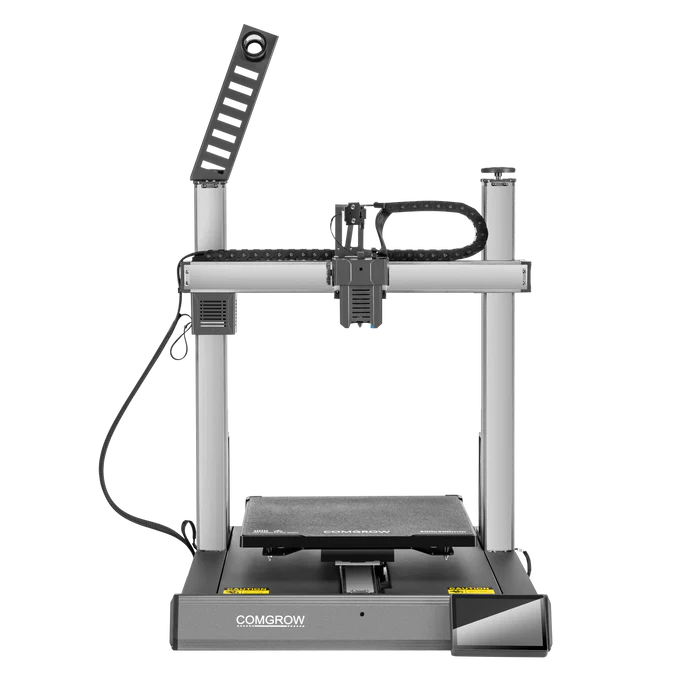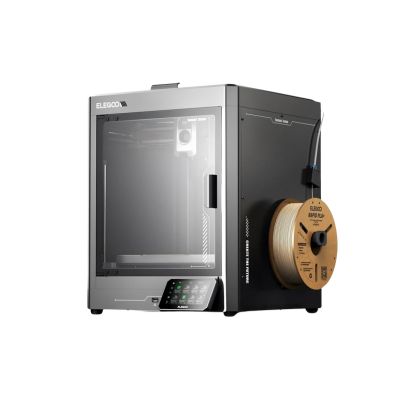Compare Comgrow T300 vs Centauri Carbon
Comparison between the best 3D printers
Choose the best 3D printer at the best price. The cheapest 3D printers are here.
Buy a 3D printer here with 3D Fila.
 |
 |
|
| Model | Comgrow T300 |
Centauri Carbon |
| Printing Material | Filament | Filament |
| Buy Filament for Sovol Comgrow T300 | Buy Filament forElegoo Centauri Carbon | |
| Estimated price | $449,00 | $500,00 |
| Manufacturer | Sovol | Elegoo |
| Release Year | 2024 | 2025 |
| Print Volume [mm] | 300x300x350 | 256x256x256 |
| Printer Size [mm] | 503x631x831 | 500x500x600 |
| Weight [kg] | 17 | 17,5 |
| Power Loss Recovery | YES | YES |
| Enclosed printer | NO | YES |
| Bed Leveling | Automatic | Automatic |
| Filament End Sensor | YES | YES |
| Bed type | Heated | Heated |
| Power supply system | Direct Drive | Direct Drive |
| Standard nozzle | 0,4 | 0,4 |
| Maximum Nozzle Temperature [°C] | 300 | 300 |
| Maximum Bed Temperature [°C] | 100 | 110 |
| Maximum printing speed [mm/s] | 600 | 500 |
| Filament holder | YES | YES |
| Camera for supervision | NO | NO |
| Recommended filaments | PLA, PETG, PET, TPU, PA, ASA, PC, PLA CE, PA-CF, PET-CF | PLA, PETG, ABS, ASA, TPU, NYLON, CARBON FIBER |
| Recommended slicers | Bambu Studio, Super Slicer, Cura, Prusa Slicer, Orca Slicer | Elegoo Slicer, Orca Slicer |
| Maximum Resolution [mm] | 0,1 | 0,1 |
| Processor | 64 bit | |
| Display | Touchscreen 5'' | Touchscreen 4,3'' |
| Power Supply | 150 W | 350 W |
| Connectivity | USB, WiFi | WiFi, SD, USB |
| Operating systems | Windows, Linux, Macbook | Windows, Linux e Macbook |
| Date of registration in the system | 2024-05-10 | 2025-02-10 |
| Release date | 2024 | 2025 |
| Extra features | The Sovol Comgrow T300 printer stands out for its technological innovations and advanced features. With a print size of 300mm300mm350mm, the T300 offers true linear rails on all axes, ensuring greater stability. Its Klipper-based intelligent core and 64-bit microcomputer increase printing speed and quality through pressure advancement and input shaping. The extruder with a gear ratio of 6.5:1 allows for more precise material control, optimizing the printing of flexible materials. In addition, the T300 features a rapid filament cooling system with a high-speed fan and a circular duct piece that improves cooling efficiency. With a 4.3-inch high-refresh rate touchscreen and an 81-point automatic leveling system, the T300 simplifies the preparation and execution of 3D prints. | The Elegoo Centauri Carbon is a CoreXY 3D printer with an enclosed structure, direct drive extruder, and hardened steel components for abrasive materials. It features automatic bed leveling, a touchscreen, a filament cutting system, and an elongated nozzle designed to reduce clogs. It offers Wi-Fi connectivity for remote file transfer and runs on a Klipper-based firmware, providing advanced control and precise adjustments. |
| Support for multiple colors and materials (AMS and CFS) | NO | NO |
Notes * |
||
| Cost-benefit | 8 / 10 | 8 / 10 |
| Hardware | 3.6 / 10 | 6 / 10 |
| Tela | . | . |
| Print volume | 4 / 10 | 4 / 10 |
| Performance | 5 / 10 | 4 / 10 |
Conclusion |
| In comparing the Comgrow T300 with the Elegoo Centauri Carbon, both printers appeal to different user needs despite their similar price range and features. The Comgrow T300, released in 2024, offers a larger print volume, advanced technological innovations, and a superior cooling system, making it especially suited for users looking for high-quality prints with greater flexibility in materials. Its light weight and strong emphasis on stability through true linear rails suggest it is designed for both speed and precision. On the other hand, the Elegoo Centauri Carbon, set to launch in 2025, features a more robust closed structure, making it ideal for users who prioritize temperature management and a controlled printing environment. Its hardened steel components allow for the printing of abrasive materials, and its automated features enhance user experience and ease of use. While both printers are closely matched in terms of features like automatic bed leveling and direct drive systems, the Comgrow T300 appears to excel in speed and printing versatility, while the Elegoo Centauri Carbon prioritizes enclosure and material robustness. Ultimately, the choice between the two should be driven by user preferences for material handling, print volume needs, and environmental considerations. Each offers a solid cost-benefit ratio, catering to different aspects of 3D printing performance tailored to various user demands. |

